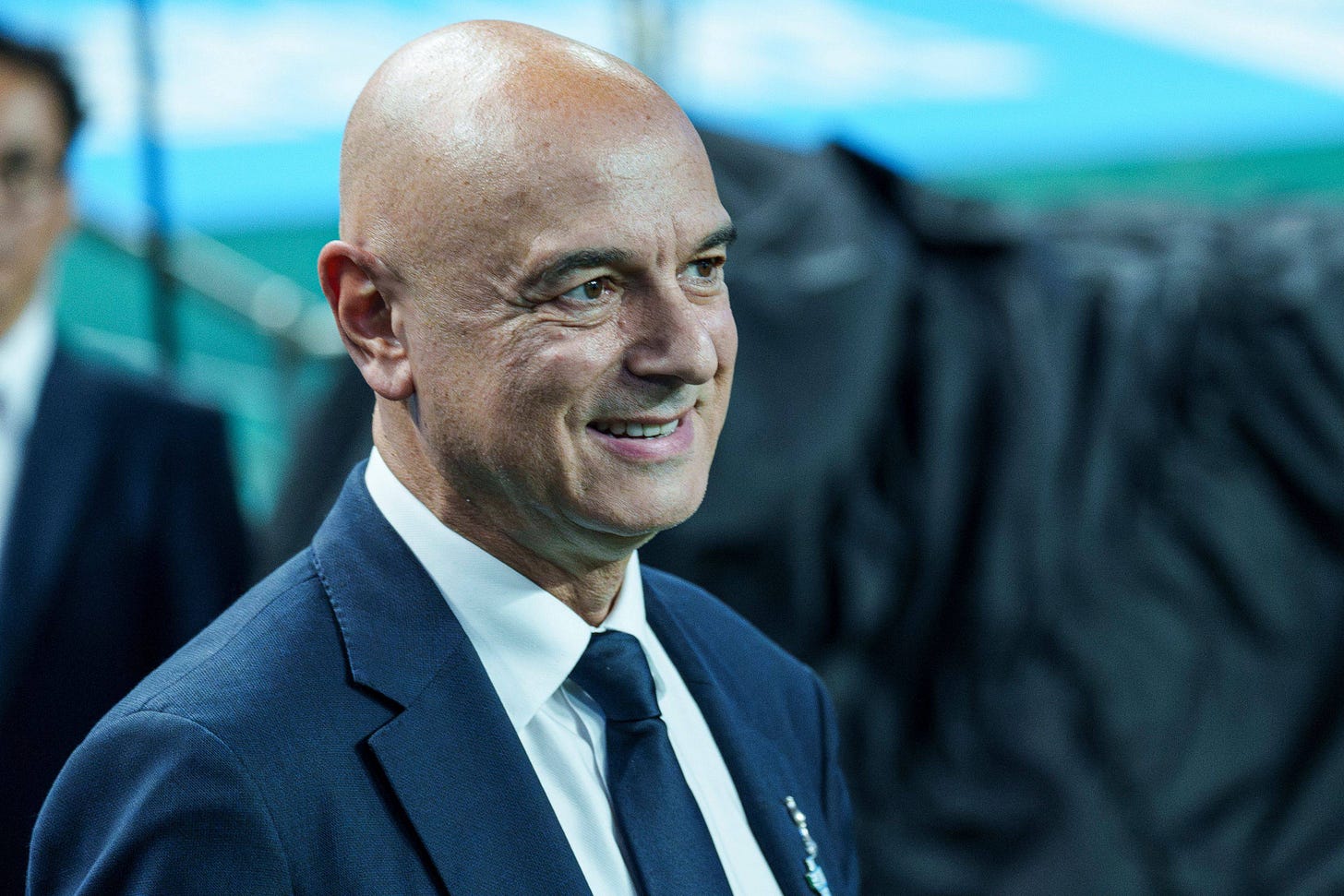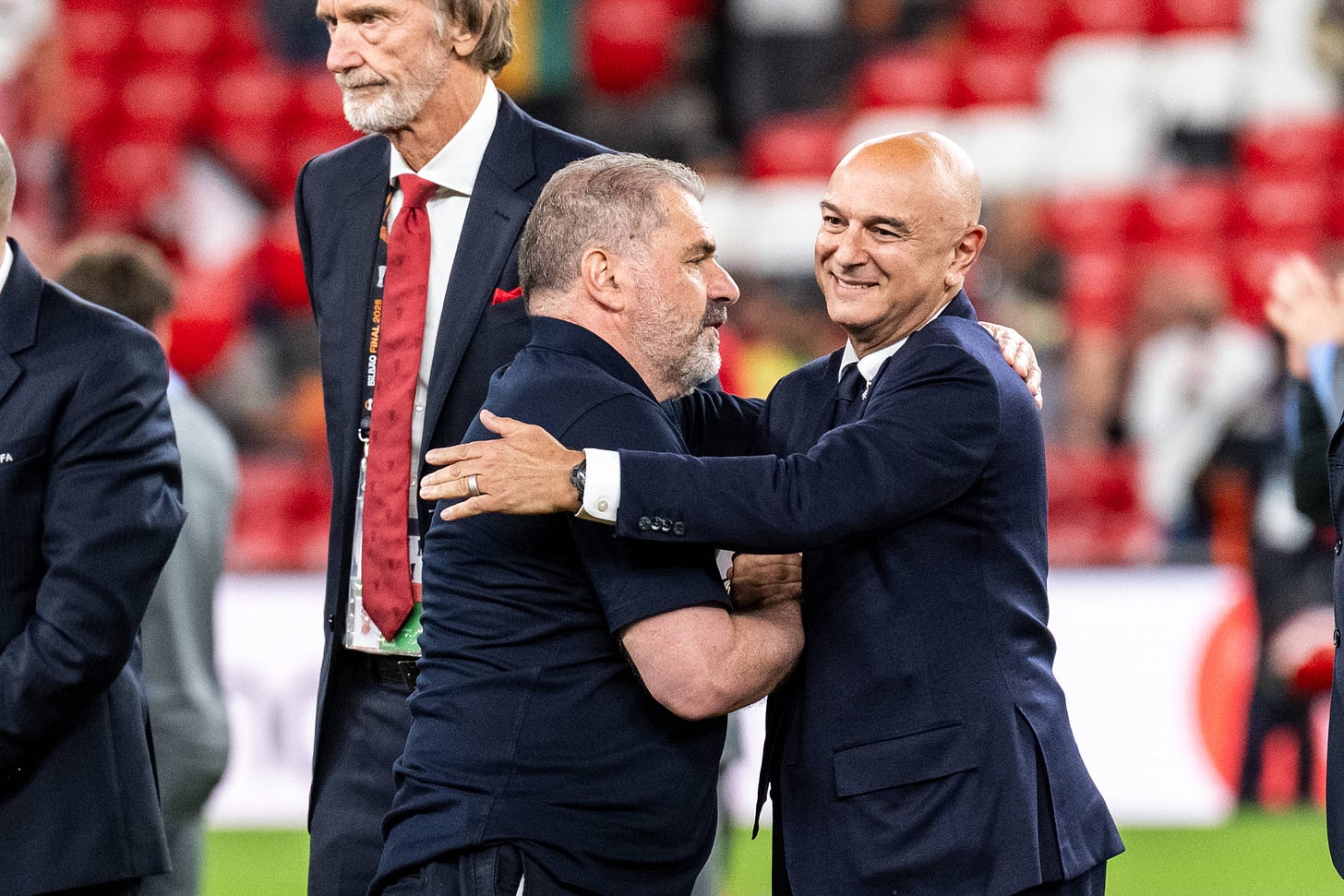Daniel Levy leaves Spurs after 25 years, what comes next in N17?
A look at his legacy, our history, and the shape of Tottenham without him
A seismic day in north London
There are days when football jolts you. Yesterday did that. On Thursday 4 September 2025, Tottenham Hotspur confirmed that Daniel Levy had stepped down as executive chairman after nearly a quarter of a century at the helm, with Peter Charrington stepping in as non executive chair and a retooled leadership taking shape around him. Whatever your view of Levy, this is the end of a defining era in the modern history of Spurs.
I have watched his reign with admiration at times, irritation at others, and more than a few moments of head shaking. Yet I cannot deny the sheer scale of what changed on his watch. Off the field, Tottenham have gone from strength to strength. On the field, even with the Europa League win last year, the project has stalled at key moments and has not consistently turned those foundations into a winning rhythm. The club’s own farewell lines recognised how far the business side has travelled, but it is fair to say they are not a global powerhouse on the pitch.
Levy in context, the long road from 2000 to now
When Levy arrived in 2000, Tottenham were a sleeping force trying to decide what they wanted to be. Two and a half decades later, the club he leaves behind is unrecognisable in scope and ambition. He departs with a reputation that splits opinion like few administrators in English football. Some see the consummate deal maker, others see a cautious hand that tightened the purse strings a little too firmly. Both things can be true.
There is no escaping the high points. Spurs reached a Champions League final, they pushed for titles in bursts, they cultivated elite players, and they built a venue that stands among the most impressive in the game. There is also no escaping the sag on the honours board. For all the smart commercial play and the swelling revenues, the trophy return was painfully thin for too long.
The stadium that changed everything
The Tottenham Hotspur Stadium did more than replace White Hart Lane, it reimagined Tottenham as an events giant, part football parish, part destination. Stand on the single tier and you feel it, the noise, the scale, the sense that the club grew up the day the turnstiles first clicked. The stadium sits at the heart of the Levy project. It helped lift Spurs into the top tier of football revenues, it attracted world class partners, it opened new doors for matchday and non matchday income, and it gave the club a platform that rivals envy. The training ground at Hotspur Way belongs in the same paragraph, a showpiece for first team and academy alike, a marker of a club that decided infrastructure should never be the excuse again.
That is the paradox of Tottenham in the Levy years. The buildings and the balance sheets say super club. The medals do not.
Managers, near misses and the identity puzzle
Where frustration hardens is the dugout churn. Across the Levy years Tottenham cycled through head coaches with very different blueprints, from tactical philosophers to fiery operators. Some were inspired for a while, some misfired quickly. The habit of moving managers on, often before an identity properly set, bred a sense of drift that supporters know all too well. It was visible after the Champions League final, it resurfaced as promising starts faded into mid season hesitations. That is part of why this moment feels like a hinge point.
The pattern was familiar. A project would spark, a style would catch, the squad would look one precise addition away from becoming a juggernaut, then the window would pass without that piece, or it would arrive late, and the moment would soften. In a league where margins at the top are microscopic, delay becomes defeat.
Transfers and the art of the deal
Levy’s reputation as a negotiator is not an invention. Ask Real Madrid about Luka Modric and Gareth Bale. Those were hard fought deals that put Spurs in a commanding bargaining position and banked serious money. The Harry Kane sale required nerve as well as nous. Any fair history of this era includes that steel. It was an edge that kept Tottenham competitive at boardroom level and it set a tone for how the club operated in the market.
Yet the flip side is familiar. Carefully staged brinkmanship sometimes meant players arrived late, or not at all, and squads went into seasons short in two or three obvious places. When the winning margin at the top is razor thin, those gaps tell. The great Tottenham sides of these years, particularly under Mauricio Pochettino, often felt one piece away, and that missing piece became the story as soon as momentum dipped.
Europa League joy, Premier League pain
Last season captured the paradox in one breath. Tottenham won the Europa League in Bilbao, a raucous, gritty night that ended a European drought stretching back to the eighties and delivered a first major trophy in many years. It was pure validation, proof that on their best nights they still know how to win.
Domestically, the campaign was a slog. Seventeenth place in the league spoke to deeper problems that a medal could not gloss. The club responded by removing Ange Postecoglou, a decision that hurt plenty of supporters who loved his straight talking, but one the hierarchy felt was necessary after months where the football lost its shape. In came Thomas Frank, a coach admired for structure, clarity and a knack for developing players. His brief is clear, build a team that runs on repeatable patterns, not sparks that fizzle by winter.
The new order and what it signals
Yesterday’s statement did more than wave goodbye. It set out a model. Vinai Venkatesham as chief executive, Peter Charrington as non executive chair, Thomas Frank in the dugout, and an emphasis on a professional executive team running the club day to day. The ownership remains unchanged and the message is stability, not upheaval. This looks like a shift toward a classical corporate structure, chief executive led, with football departments empowered to run the sporting project.
Read the direction of travel and a picture forms. Tottenham are not for sale, they want to translate financial strength into sporting rhythm, and they believe a clear chain of command will help. That is the promise. The test will be whether the execution finally matches the intent, and whether recruitment and retention align with a football philosophy rather than lurching from one style to another.
The balance sheet of a legacy
It is easy to turn a figure like Daniel Levy into a cartoon, either saint or villain. I do not buy either version. He was a formidable chairman who delivered transformational projects and wrestled with the impossible balancing act that English football places on modern executives. On the positive side of the ledger sits a world class stadium, a training ground to match, a global commercial footprint, consistent European qualification across long stretches, and a financial position that protected the club through storms that rocked the game.
On the other side, the honours list stayed too short for too long, the managerial carousel spun too often, the transfer windows sometimes left holes everyone could see, and the sense of a footballing identity kept slipping from Tottenham’s grasp at the moment it needed to harden. Both sides must be acknowledged if we are to be honest about what these twenty five years meant.
History as a compass
Tottenham’s story has always carried a certain romance. Bill Nicholson’s creed about doing it with style still echoes through the stands. Keith Burkinshaw’s European nights, the artistry of Hoddle and Ardiles, the modern electricity of Bale and Modric, and the collective surge of the Pochettino years, all of it feeds the expectation that Spurs should be both competitive and compelling. Levy’s era gave the club the physical tools to live up to that story again, the bricks, the mortar, the revenue engines. The next chapter must confirm that those tools were a foundation, not a monument.
What the future looks like without Levy
A Tottenham without Daniel Levy will feel different, and that is the point. The chairman became the face of the club, the lightning rod for praise and anger alike, and the author of its biggest business decisions. Removing that presence from the day to day should change the cadence of decision making. With a strong chief executive and a defined football department, lines of accountability can sharpen. With a non executive chair, governance becomes about stewardship, not touchline proximity.
The basics for success are in place. The stadium draws the world to N17, the training ground supports development, the academy continues to produce. A coherent recruitment plan that matches Thomas Frank’s approach can tilt tight games and shore up the soft spots that hurt last season. Contract strategy needs to be assertive, extend early when the trajectory is clear, move on decisively when profiles no longer fit. Communication with supporters should be frank and regular, because expectation thrives on clarity.
For the women’s side, continued investment and alignment with the same performance principles can accelerate progress. The stadium has already hosted landmark moments for the women’s game, and the brand power of Spurs is a lever that can be pulled with greater intent.
Commercially, Tottenham are set to remain a powerhouse. The job now is to keep the events calendar humming without allowing it to overshadow football priorities. The lesson of the last few years is simple, business excellence should be the servant of sporting excellence, not the other way around. A clean structure helps that.
How supporters may process the change
Many will feel relief. Others will feel gratitude. Many will feel both. Levy brought stability when the club needed it, and he leaves as the most consequential chairman in Tottenham’s modern history. He also leaves with arguments unresolved, about how much risk a club should take to bridge the final gap, about how patient a project should be in the face of a bad month, about where values sit when money and trophies compete for primacy.
What matters now is that Tottenham choose a lane and stay in it. If the identity is intensity with the ball and structure without it, hire for it, train for it, live with the rough edges until the rhythm sets. If the identity is talent development married to smart sales, build the pipeline and control the exits. Fans can tolerate a rebuild when they can see the plan and feel the progress. They struggle when the plan feels like a moving target.
Closing thoughts
Daniel Levy’s time at Tottenham will be argued over for years, as it should be when a figure has shaped a club so completely. He leaves a ground to be proud of, a global presence that many clubs would envy, and a ledger that shows plenty of prudence. He also leaves a fanbase desperate for a sustained period where football comes first, where clarity of purpose on the pitch defines the conversation.
Tottenham without Daniel Levy begins now. The tools are there, the leadership model is drawn, the head coach is in place. From here on, results will write the history. For those who care deeply about this club, the hope is simple, that the next twenty five years are measured not only by balance sheets and buildings, but by afternoons and evenings where Spurs take the initiative and bring silver back to the cabinet with regularity.



